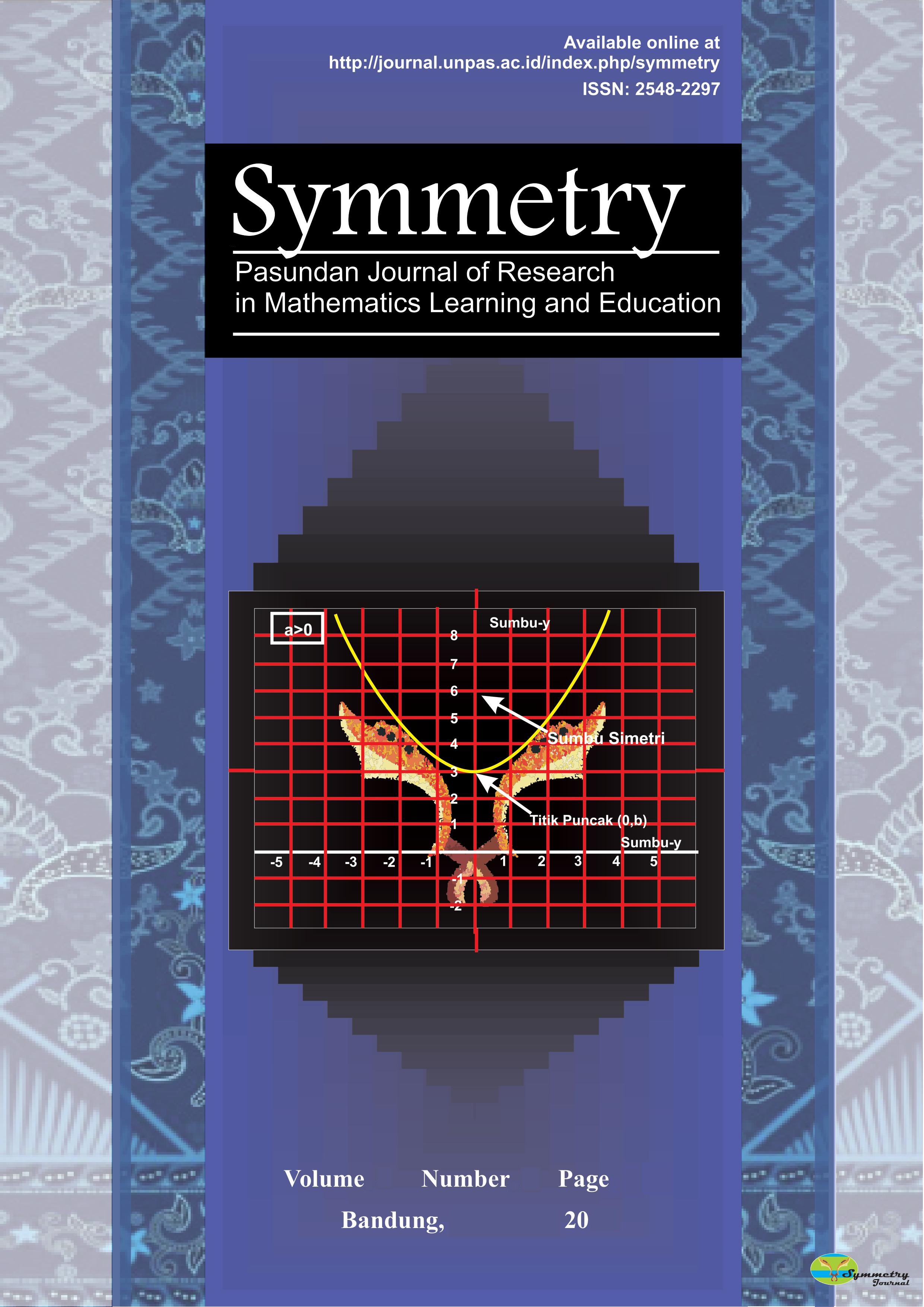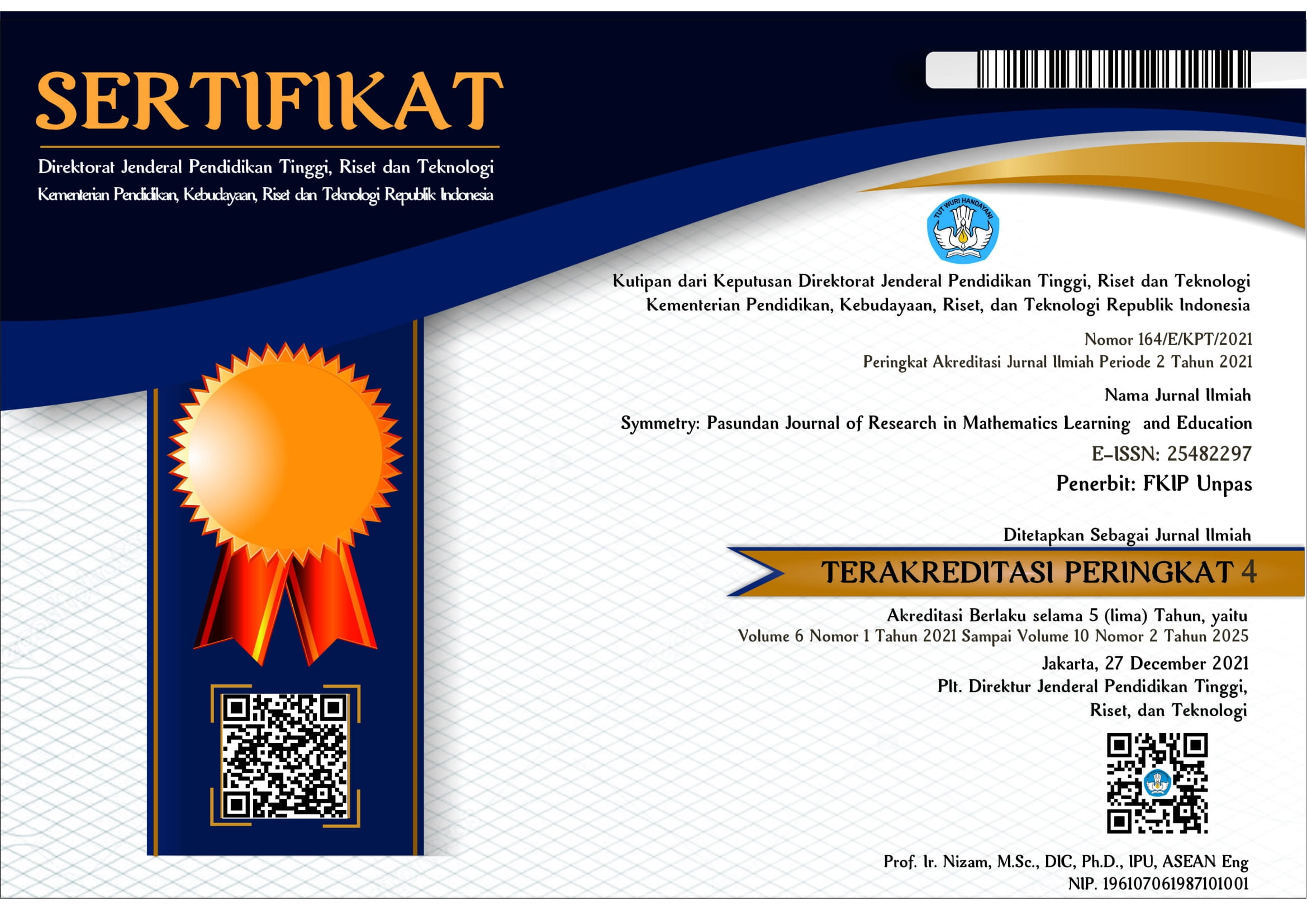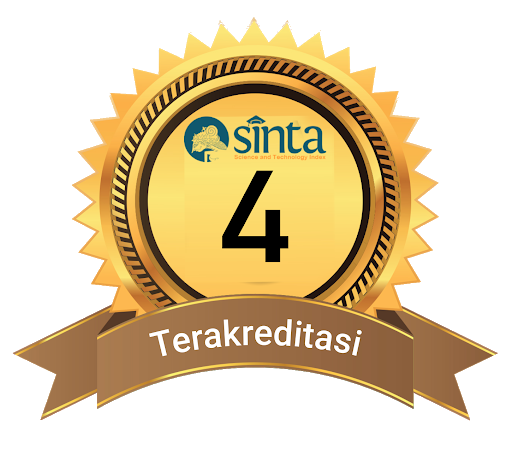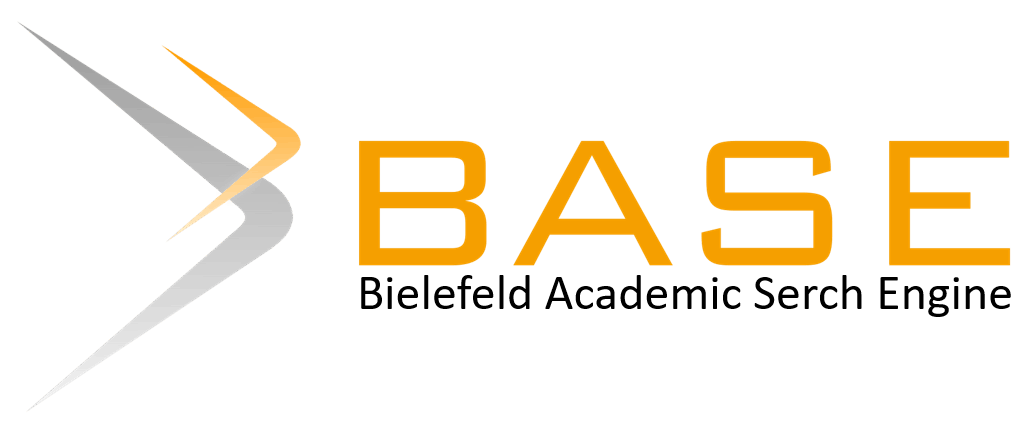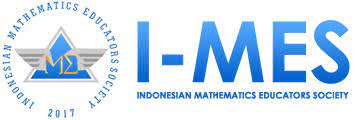Indonesian Students’ Conceptual Understanding in Mathematics based on Learning Style: Systematic Literature Review (SLR)
DOI:
https://doi.org/10.23969/symmetry.v7i2.6409Keywords:
Conceptual Understanding, Learning Style, SLRAbstract
This study aimed to describe the research results related to students’ conceptual understanding in mathematics analyzed based on their learning style. The method used in this study was Systematic Literature Review (SLR). The sample consists of 17 articles indexed in SINTA and Google Scholar, published in 2018 until October 2022, and located in Indonesia. The description in this study will be reviewed based on the year of publication, journal indexes, method uses, level of education, number of subjects, subject matters, research locations, and the theory used in learning style. Through the SLR method, it was found that there was an increasing and decreasing in the number of articles, there were dominantly published in Google Scholar, qualitative method was dominant, the research conducted in junior high school dominant, 14 out of 17 researchers used less than 30 subjects, algebra was dominant followed by geometry and measurement, the research was dominant conducted in Java, DePorter and Hernacki theory were dominantly.
Downloads
References
Adawiyah, I and Kurniasari, I. (2020). Profil Pemahaman Konsep Matematika Siswa Pada Materi Trigonometri Berdasarkan Gaya Belajar Grasha-Riechmann. MATHEdunesa Jurnal Ilmiah Pendidikan Matematika, 9(1), 15-23.
Aini, P.A., Hariyani, S., dan Suwanti, V. (2020). Analisis Pemahaman Konsep Matematika Ditinjau dari Gaya Belajar Siswa Menurut Teori Honey Mumford. Jurnal Pendidikan dan Pembelajaran, 6(2), 44-52.
Aliyah, U., & Mulawarman, M. (2020). Kajian Systematic Literature Review (SLR) Untuk Mengidentifikasi Dampak Terorisme, Layanan Konseling dan Terapi Trauma Pada Anak-Anak. ISLAMIC COUNSELING Jurnal Bimbingan Konseling Islam, 4(2), 209. https://doi.org/10.29240/jbk.v4i2.1759
Ariati, C., & Juandi, D. (2022). Kemampuan Penalaran Matematis: Systematic Literature Review. LEMMA: Letters Of Mathematics Education, 8(2), 61–75.
Aswin, A., & Juandi, D. (2022). Using Watson Criteria for Analyzing Student Errors: Systematic Literature Review (SLR). Hipotenusa : Journal of Mathematical Society, 4(1). https://doi.org/10.18326/hipotenusa.v4i1.7239
BSKAP. (2022). Lampiran II Keputusan Kepala Badan Standar, Kurikulum, dan Asesmen Pendidikan Kemendikbud Ristek Nomor 008/KR/2022. Jakarta
DePorter, B. & Hernacki, M. (2013). Quantum Learning. Bandung: PT Mizan Pustaka.
Elkatawneh, H. H. (2016). Comparing Qualitative and Quantitative Approaches. SSRN Electronic Journal. https://doi.org/10.2139/ssrn.2742779
Friantini, R. N., Winata, R., Annurwanda, P., Suprihatiningsih, S., Annur, M.F., Ritawati, B., Iren. (2020). Penguatan Konsep Matematika Dasar Pada Anak Usia Sekolah Dasar. Jurnal Abdimas Bina Bangsa, 1(2), 276-285.
Hidayat, P. W. (2018). Analisis Profil Minat Belajar dan Kemampuan Pemahaman Konsep Dasar Matematika SD Pada Mahasiswa S1 PGSD STKIP Muhammadiyah Muara Bungo. Lemma, 4 (1).
Juandi, Dadang, & Tamur, M. (2020). Pengantar Analisis Meta. UPI PRESS
Karunia, E. P., & Mulyono. (2016). Analisis kemampuan pemahaman konsep siswa kelas VII berdasarkan gaya belajar dalam model knisley. Prosiding Seminar Nasional Matematika, 339.
Khairunnisa, A., Juandi, D., & Gozali, S. M. (2022). Systematic Literature Review: Kemampuan Pemahaman Matematis Siswa dalam Menyelesaikan Masalah Matematika. Jurnal Cendekia: Jurnal Pendidikan Matematika, 6(2), 1846-1856.
Khoirunnisa, A., dan Soro, S. (2021). Analisis Kemampuan Pemahaman Konsep Matemattis pada Materi SPLDV Ditinjau dari Gaya Belajar Peserta Didik. Jurnal Cendekia: Jurnal Pendidikan Matematika, 5(3), 2398-2409.
Kilpatrick, J., Swafford, J., dan Findell, B. (2001). Adding It Up: Helping Children Learn Mathematics. Washington, DC: The National Academies Press.
Kitchenham, B. (2007). Guidelines for performing Systematic Literature Reviews in Software Engineering. https://www.researchgate.net/publication/302924724
Liberati, A., Altman, D. G., Tetzlaff, J., Mulrow, C., Gøtzsche, P. C., Ioannidis, J. P. A.,Clarke, M., Devereaux, P. J., Kleijnen, J., & Moher, D. (2009). The PRISMA statement for reporting systematic reviews and meta-analyses of studies that evaluate health care interventions: explanation and elaboration. In Journal of clinical epidemiology (Vol. 62, Issue 10). https://doi.org/10.1016/j.jclinepi.2009.06.006
Paré Guy, Trudel Marie-Claude, Jaana Mirou, Kitsiou Spyros. (2015). “Synthesizing Information Systems Knowledge: A Typology of Literature Reviews.” Information & Management 52:183–99.
Setiana, D., Cahyono, B., and Rohan, A.A. (2019). Analisis Kemampuan Pemahaman Konsep Matematis Peserta Didik pada Materi Trigonometri Berdasarkan Gaya Belajar. Jurnal Phenomenon. 9(2), 176-189.
Susanto, A. (2013). Teori Belajar dan Pembelajaran di Sekolah Dasar. Jakarta: Kencana Prenamedia Group.
Triandini, E., Jayanatha, S., Indrawan, A., Werla Putra, G., &Iswara, B. (2019). Systematic Literature Review Method for Identifying Platforms and Methods for Information System Development in Indonesia. Indonesian Journal of Information Systems, 1(2), 63
Virgana. (2019). Understang of Mathematical Concepts Through Cooperative Learning, and Learning Styles. Journal of Education and Learning, 13(2), 212-218
Wijayanti, A., Safitri, P.T., and Raditya, A. (2018). Analisis Pemahaman Konsep Limit Ditinjau dari Gaya Belajar Interpersonal. Prima: Jurmal Pendidikan Matematika, 2(2), 157-173
Xiao, Y., & Watson, M. (2019). Guidance on Conducting a Systematic Literature Review. Journal of Planning Education and Research, 39(1), 93–112. https://doi.org/10.1177/0739456X17723971
Zakirman. (2017). Pengelompokkan Gaya Belajar Mahasiswa Menurut Teori Honey Mumford Berdasarkan Intensitas Kunjungan Pustaka. Jurnal Bimingan dan Konseling, 4(1), 1–74
Downloads
Published
Issue
Section
License
Copyright (c) 2022 Symmetry: Pasundan Journal of Research in Mathematics Learning and Education

This work is licensed under a Creative Commons Attribution 4.0 International License.
Hak Cipta sepenuhnya ditangan jurnal.

